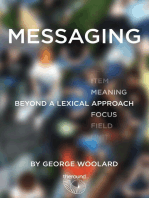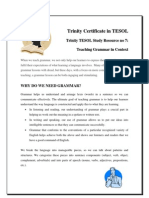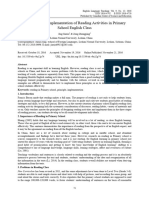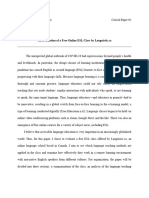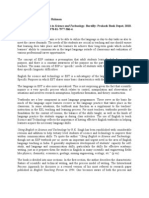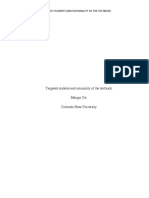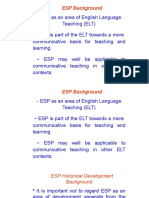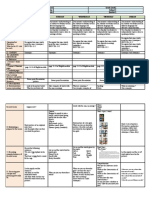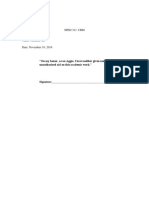Text Assessment
Text Assessment
Uploaded by
api-253452994Copyright:
Available Formats
Text Assessment
Text Assessment
Uploaded by
api-253452994Original Title
Copyright
Available Formats
Share this document
Did you find this document useful?
Is this content inappropriate?
Copyright:
Available Formats
Text Assessment
Text Assessment
Uploaded by
api-253452994Copyright:
Available Formats
Textbook Assessment READING LEVEL This textbook, Bien dit!
, weighs in on the Fry readability graph (data shown in following table)
Page No. 51 89 152 Average Syllables 175 156 162 164.3 Sentences 7.4 7.6 5.9 6.96 Result: Directly in the middle of 10th and 11th grade reading level segment, inside the curve
TEXTBOOK Champeny, S, DeMado, J, Ponterio, M, Ponterio, R. (2008). Bien dit!. (French 1A.) Austin: Holt, Rinehart and Winston EVALUATION Bien dit! Is a textbook meant for 7th, 8th, and 9th grades who are level French 1. The readability of this textbook was determined to read between a 10th and 11th grade level as
quantified by the Frye model. Through reading Chapter 5 Assessment of Students and Textbooks, Readability formulas are quantitative yardsticks for estimating differences in difficulty among texts. (Alvermann, Phelps, Gillis 161). In my opinion I find it difficult to determine a texts readability by means of numbers and formulas. Though a formula determines the readability from an objective standpoint, I still believe there are many flaws. Some say that readability formulas measure word length or frequency and sentence length. In using the formulas we accept that these features affect readability in a significant way (Plainlanguage). When it comes to a foreign language textbook of course there are going to be many recurring words, repetition is one key to learning a language. So to incorporate a foreign language as well as trying to quantify sentence length and word frequency will of course affect the readability of this textbook. These readability formulas also dont take into account the recognition of nonEnglish words and will determine the difficulty and readability much higher than it should be. The Chapter Five excerpt discusses two assumptions that readability formulas make, first that longer sentences equates more syntactic complexity and second that unfamiliar and longer words make a text harder to read. It is understandable that longer sentences and more difficult words will be used to quantify a high readability because those aspects of a text may be used to portray abstract ideas and concepts while simpler words express more concrete ideas. In recent years, researchers have emphasized that readability tests can only measure the surface characteristics of text. Qualitative factors like vocabulary difficulty, composition, sentence structure, concreteness and abstractness, obscurity and incoherence cannot be measured mathematically (Plainlanguage). I believe the subject approach should be taken when deciding on readability because only educators of the subject should be able to determine whether a textbook is appropriate for a classroom. Bien dit! Has a good mixture of simple, comprehensible French
language in comparison to English and I feel is appropriate for a 7th or 8th grade classroom. Students in my practicum classes use this book with ease and my practicum teacher voices few complaints about its contents and structure.
Content: This textbook has an enormous degree of varying activities to support the content and lessons to be taught. The chapters contain vocabulary supported by visual aids which the new words are introduced and labeled onto corresponding pictures. Because this textbook provides corresponding pictures and scenarios to new vocabulary it makes the information binding for students. Though the English translation is given with many vocabulary words, which we are learning to try to avoid, I dont feel that it is a hindrance to the learning. There are corresponding culture sections with each chapter that help to immerse the students in a foreign culture. The problem is the majority of these culture sections are written in English. This begins the debate already in French 1A of how is a student supposed to understand a different culture if not learning it through its own language. There are many written exercises for the students to practice with but not many reading or oral sections. It is important to incorporate all three aspects so that students will be well rounded in all the areas of communication. Student collaboration is important within lessons so students not only learn from the teacher but share ideas with each other. This textbook doesnt provide many activities for pair or group collaboration.
Format: The format is initially overwhelming because of the amount of activity occurring on the pages. The pages are extremely bright and full of pictures and movements and words that it can become overwhelming and confusing. Too many new words and pictures jumping off the page will stress the student out. Grammar is important when learning a new language but is something that should be stressed later in the education process. Initially foreign language
should be taught through communication but many of the chapters within this textbook are very grammar driven. Rather than multiple practices with phrases and verbs and vocabulary, the focus is on tedious grammar objectives such as adjective agreements, contraction with and de, or when to use Cest versus Il/Elle. Although this textbook does have culture sections at the end of every chapter, it is not incorporated enough throughout the chapters and textbook as a whole. Culture should be at the heart of each lesson but within this textbook it gets pushed off to two pages at the end of each chapter. In the back of the book, there are many pages that provide supplemental vocabulary that isnt included in the English and French glossary. There is also a good, short idiomatic expression section that is interesting for students to look at. I find the maps in this book to be a pitiful display of the francophone countries around the world. Having bland cartoon maps doesnt convey any realistic geographic or cultural perspective for students.
Utility: The utility of this text is I believe overall useful in the classroom. Many of the activities are helpful for students. They provide many outlets to practice writing the language and also reading the language. It provides a good guide for the teacher to base his/her lessons around because I feel that the material flows smoothly and sequentially appropriate throughout the textbook. Where I think it lacks in its usefulness is in the aspect of cross interdisciplinary material. This textbook focuses largely are teaching solely the language and even lack in its own culture section. There arent many ties to literature, history, or science courses throughout the chapters. This makes it difficult for students to potentially see meaning and purpose behind what they are learning because it doesnt tie into real world application.
Style: The style of the text is written in an appropriate level if not maybe a little immature for 7th-9th grade level students. But I feel that this aids with the learning of the language. The
sentences are written with simplicity so as to be easily comprehensible. There are many visual aids and photos how ever many of them are cartoon pictures. I think that because these students are still early adolescents they most likely enjoy the cartoon style pictures and the stand out color and animation. The culture sections I feel are written too vaguely. One paragraph doesnt suffice to describe the French eating pattern or French African past times. Because of the immaturity of these written culture sections, it doesnt challenge the students thinking or provide enough information to promote more profound discussions. Also because this textbook style is written at such a beginner level, I dont feel that the activities scaffold themselves to challenge the advanced students who maybe become bored with the simplicity.
EVALUATION SUMMARY with rationale for each of the 3 strengths/3 weaknesses Strengths: The multiple activities provide the students with multiple opportunities for learning the target language. With the written activities in this textbook, students are able to practice the language in written form. Writing the language gives the students a visual representation they can reflect and make connections. They are able to read the French questions and sentences and then think about, in French, the different ways to answer the questions. The activities in the textbook allow for the teacher to interpret different ways to manipulate them. In the teachers edition, there are excerpts of instructional notes to inform the teacher of different pair or group work, and interactive games and activities. Because the textbook doesnt provide many oral and reading activities this allows the teacher the opportunity to create their own. The multiple activities also aid the students and their different learning styles. This enforces their interest and focus on the lesson.
The flow of material throughout this textbook sequentially fits a pattern to promote the progressive learning of a foreign language. Commonly, as occurs with other level on language textbooks, beginning with greetings and introductory conversational phrases. This is because this is the basis for communication. The lessons that follow are simple with their contents. They isolate the most common irregular verbs such as to: to have, to be, to go, and to do. The chapters, using the verbs, will contain corresponding material. For example in the chapter teaching the verb Faire= to do, the other grammatical contents besides the verbs conjugation will consist of idiomatic expressions using faire and elaborate with corresponding vocabulary and culture. When learning faire, students learn phrases such as faire du sport which the chapter will contain the vocabulary pertaining to sports, activities, and hobbies and finish with a culture section of popular French past times and hobbies. I feel that the reference used in this textbook provide good and useful supplemental support for the students. There are verb conjugation charts that provide and explain many common French verbs, their usage, and tense forms. For students to try to understand more common and colloquial French phrases there is a small idiomatic expressions section. If feel this is interesting for students to be familiar with because idiomatic expressions reveal small windows into French culture and common speak. For example, in America we say its raining cats and dogs whereas in France they say il pleut des cordes, its raining cords. There can derive multiple discussions of how the expressions differ and reflect culture. This textbook provides an excellent English and French dictionary. It is useful where it contains other words not solely found in the textbook so the students are able to reference it before having to find a dictionary.
Weaknesses: Because there is too much going on in the pages the students can become overwhelmed. With all of the examples, pictures and words they will stress out thinking that
there is more material to learn than there actually is. The pictures and text boxes of vocabulary and phrases are extremely vibrant and colorful which yes is attention grabbing but also can be distracting. Having a stressed student isnt conducive to learning and may force then to abandon the material as a whole. I think that if the material in the textbook was more spread apart with limited lessons and grammatical teachings per page, then the learning wont feel as pressured and heavily weighted. Culture is one of the most important aspects when learning another language and should be at the heart of the education process. As was mentioned earlier it is common practice now to understand the teaching a foreign language cannot be done effectively when not taught through culture. This book lacks in authentic perspective and meaningful and relatable culture sections. The culture provided are done in short excerpts that give the students a vague overview of what life in a francophone country is like. They are very unrelatable and the students rarely make connections with what they read between American and francophone cultures. I also noticed that the culture sections are a measly one or two pages at the end of a chapter when in actuality we should be finding cultural references throughout the chapters and textbook. Also in a sense it is redundant when many of the culture sections are written in English because how can one learn and understand a culture if not through the target language? This textbook provides little to now information of cross interdisciplinary learning relating information to other core classes of the students. It becomes difficult to relate and connect to the information when they dont see purpose in it. When students start to see learning connect between different subjects they realize how realistic and relatable the information is. They also encounter more practice with the material and more exposure so they will comprehend better.
ADAPTING TEXT FOR STUDENTS
To use the text successfully in the French classroom the instructor will need to adapt many of the activities in order to accommodate for the learning of the three modes of communication reading, writing, and oral. This book provides enormous amounts of writing activities but lacks in the reading and oral department. It will take creative manipulation of the activities to create reading and writing activities for students. It shouldnt be difficult but for teachers who teach straight from the textbook, the students may be lacking at the end of the course. Also in order to adapt the text for students, if feel that the instructor should make their own notes sheets so as to try and isolate and spread out the information. With the pages being crammed full of pictures and words the students may need a clearing visual of the specific information for the lesson. The lesson plan can be easily made by the instructors for class because the chapters flow well together. The instructor should be able to witness a progressive improvement in the students language skills. Because this text lacks in culture, the instructor will need to adapt the sections and provide their own material and culturally authentic examples to share with the students. Incorporating personal experiences during these times will also be important and interesting for students. Reference: Alvermann, D. E., Phelps, S. F., & Gillis, V. R. (2010). Content area reading and literacy: Succeeding in todays diverse classrooms (6th ed.). New York: Allyn & Bacon. Cheryl Stephens, (2000), All About Readability, 04/22/14 http://plainlanguage.com/newreadability.html My Byline Media, Free Text Readability Consensus Calculator, 04/22/14, http://www.readabilityformulas.com/free-readability-formula-tests.php
Polly Platt (2000-2011) French or Foe, 04/22/14, http://www.pollyplatt.com/pages/frenchfoe.htm This book provides real life anecdotes from Polly Platt about an American living in France. She explains many of the misconceptions and stereotypes about the French and why they live and act the way they do. This is seen as a guide of how to interact with French people and not stick out like a sore thumb. This book helps alleviate some of the lack of cultural material in this textbook. By addressing stereotypes and misconceptions about the French that we hold as Americans, it will intrigue students as well as inform them about a different way of life and why we may feel the way they conduct their lives is bizarre to us.
Ganeri, A, (2005), France and the French, Mankato, Minnesota: Stargazer Books
This book discusses French history throughout the centuries. This book teaches the history of the different monarchies, formations of the country, to political and economic policies of the modern day. It provides a good historical overview of the development of France as a country. This book can be used to supplement the lack of historical references left from the textbook and promote cross interdisciplinary learning. This book is also a great use for beginner level classes as the information isnt too sophisticated.
Cunningham, A, (2000), Impressionists, Parragon This book is about paintings and painters of the impressionist era. It provides artistic and historical information about many famous French painters who impacted culture and an artistic era. This book can be used to supplement the lack of culture and historical information by the textbook of the artistic impact left by France. Students will learn the cultural influence French artists had on culture throughout the world. This also incorporates cross interdisciplinary learning.
Holt, Rinehart and Winston, (2003), Joie de lire, United States of America
This book provides the students with many reading activities to practice this mode of communication. There are many excerpts written where students can read, answer questions, and have following discussions. The passages range from small paragraph excerpts to larger ones. This book supplements the lacking of reading material left from the Bien dit! Textbook. Students have many opportunities with this to practice their reading of French material. They are able to read silently and out loud and have discussions about the reading in French or English.
Gale, S, (1995), West African Folktales, United States of America: NTC Publishing Group This book contains folktales, stories, and legends passed down through West African countries. West Africa contains many French speaking countries where these stories reflect the culture this side of the francophone world. These stories are written in English but still help to reflect some of the cultural aspects of these countries. This book supplements the lacking of culture from the textbook and shows the students the French African side of francophone countries, not just France. French African countries have a large impact on the French speaking world.
Vague presentation of culture. Small, undescriptive paragraphs.
Too much material/information on a page. Lots of colors and pictures but can become overwhelming.
Idiomatic expressions. Good references as an aid for students.
You might also like
- Jerry G. Gebhard - Teaching English As A Foreign or Second Language A Self-Development and Methodology GuideDocument20 pagesJerry G. Gebhard - Teaching English As A Foreign or Second Language A Self-Development and Methodology Guidedriss baouche62% (13)
- Messaging: beyond a lexical approach in ELTFrom EverandMessaging: beyond a lexical approach in ELTRating: 5 out of 5 stars5/5 (1)
- Alana Cosgrove Culture Assignment 2Document9 pagesAlana Cosgrove Culture Assignment 2api-335878086No ratings yet
- Teaching Idioms Through Role-Play 3Document148 pagesTeaching Idioms Through Role-Play 3Alina Cretu100% (2)
- Professional LitDocument5 pagesProfessional Litapi-301154896No ratings yet
- The Whole Language Approach Vs Grammar TranslationDocument9 pagesThe Whole Language Approach Vs Grammar TranslationMartha Sanzmo0% (1)
- Literature As Data Table - Level 3 Rev Fall 2022Document7 pagesLiterature As Data Table - Level 3 Rev Fall 2022api-579830025No ratings yet
- Module 10.0: Introduction: Pre-Chapter QuestionsDocument11 pagesModule 10.0: Introduction: Pre-Chapter QuestionsIvy Mie SagangNo ratings yet
- Article - N - Techniques and Methods For Improving Reading SkillsDocument3 pagesArticle - N - Techniques and Methods For Improving Reading SkillseLockNo ratings yet
- Magdalena Bobek: Materials Designed For English Language Teaching A Critical EvaluationDocument12 pagesMagdalena Bobek: Materials Designed For English Language Teaching A Critical EvaluationArt VilNo ratings yet
- English Grammar Is A Term That Has Been An Integral Part of My Life For Over Ten Years NowDocument3 pagesEnglish Grammar Is A Term That Has Been An Integral Part of My Life For Over Ten Years Nowozesl8138No ratings yet
- Workbook Jean Paul AnalyseDocument3 pagesWorkbook Jean Paul Analyseapi-724706240No ratings yet
- Possition Paper On Teaching Grammar PDFDocument9 pagesPossition Paper On Teaching Grammar PDFapi-289724333No ratings yet
- Stages of Second Language AcquisitionDocument8 pagesStages of Second Language AcquisitionTerriPlezNo ratings yet
- Final Academic Language Study Guide1Document11 pagesFinal Academic Language Study Guide1api-547661063No ratings yet
- ApproachesDocument7 pagesApproachesZeeshan LiaquatNo ratings yet
- Grammar in Context CertTESOLDocument6 pagesGrammar in Context CertTESOLIka Asto100% (1)
- Summary - 4 Skills TeachingDocument5 pagesSummary - 4 Skills TeachingMosfata HamedNo ratings yet
- 5 StraightforwardDocument10 pages5 Straightforwardapi-264101017100% (1)
- Grammar Translation Vs SuggestopediaDocument10 pagesGrammar Translation Vs SuggestopediaDumitriţa ChiricaNo ratings yet
- StraightforwardDocument10 pagesStraightforwardapi-257935780No ratings yet
- L S A F L T N F, P .D.: Earning Tyles Pplications For Oreign Anguage Eachers Ancy OSS HDocument3 pagesL S A F L T N F, P .D.: Earning Tyles Pplications For Oreign Anguage Eachers Ancy OSS Hsvendriyati asthariNo ratings yet
- The Use of Code-Switching by The Teacher in A Language Classroom by Mayra MaciasDocument6 pagesThe Use of Code-Switching by The Teacher in A Language Classroom by Mayra MaciasMayra MaciasNo ratings yet
- Book Analysis: Dewi Diansari 2215081428Document5 pagesBook Analysis: Dewi Diansari 2215081428Dewi DiansariNo ratings yet
- Materials For Teaching Vocabulary and GrammarDocument4 pagesMaterials For Teaching Vocabulary and GrammarGreen Grass100% (1)
- Principles and Implementation of Reading ActivitieDocument5 pagesPrinciples and Implementation of Reading Activitiesamdarith168No ratings yet
- Literacy Development StrategiesDocument5 pagesLiteracy Development Strategiesapi-252459916No ratings yet
- Full Paper-Ou Conference-FinalDocument12 pagesFull Paper-Ou Conference-FinalDuc DaoNo ratings yet
- Hoca Sınav KonularıDocument17 pagesHoca Sınav KonularıKadir ArıcıNo ratings yet
- Beatrice Hersh-Tudor FRE496 Philosophy of Foreign Language TeachingDocument7 pagesBeatrice Hersh-Tudor FRE496 Philosophy of Foreign Language TeachingBea Hersh-TudorNo ratings yet
- Proposal - Bab 1 2 3Document48 pagesProposal - Bab 1 2 3Oz Nugroho80% (15)
- Documento Sin TítuloDocument19 pagesDocumento Sin TítuloAlberto PinedaNo ratings yet
- Report-Teaching English Ministery of EduDocument21 pagesReport-Teaching English Ministery of EduSohrab KhanNo ratings yet
- Grammar Teaching MethodDocument21 pagesGrammar Teaching MethodBukhari Shafie100% (1)
- Coursebook Evaluation: Universidad Católica de La Santísima ConcepciónDocument14 pagesCoursebook Evaluation: Universidad Católica de La Santísima ConcepciónRandiBagusSantosoNo ratings yet
- 373 653 2 PBDocument8 pages373 653 2 PBGary Wilson 12249030No ratings yet
- The Grammar Translation MethodDocument4 pagesThe Grammar Translation MethodgjkjNo ratings yet
- MGR Framework For ml3Document5 pagesMGR Framework For ml3api-403388857No ratings yet
- TA10 SGV EbookDocument224 pagesTA10 SGV EbookChu MỹNo ratings yet
- Face 2 FaceDocument5 pagesFace 2 Facenicomartha97No ratings yet
- Rian, JP (2020) Lessons From Four-Skills 'General English' CoursebooksDocument19 pagesRian, JP (2020) Lessons From Four-Skills 'General English' CoursebooksJoel RianNo ratings yet
- Feliciano. Critical Paper#2.Document8 pagesFeliciano. Critical Paper#2.pefelicianoNo ratings yet
- Using English in Science and TechnologyDocument3 pagesUsing English in Science and TechnologyRAM KRISHNA SINGH100% (3)
- Analysis of Text Book - Anelise, Bárbara, Bruno, Camille, Luana and RobinsonDocument2 pagesAnalysis of Text Book - Anelise, Bárbara, Bruno, Camille, Luana and RobinsonBruno KutelakNo ratings yet
- Goals of The CourseDocument4 pagesGoals of The CourseDarius LedeNo ratings yet
- Teaching Productive Skills (My Summative Task)Document3 pagesTeaching Productive Skills (My Summative Task)MNo ratings yet
- Coursebook Analysis - Docx-2Document12 pagesCoursebook Analysis - Docx-2Nika NiksNo ratings yet
- Reading in Secondary SchoolDocument10 pagesReading in Secondary Schoolmungovo prosperNo ratings yet
- Foundation - Online Unit 4Document14 pagesFoundation - Online Unit 4Christine Mae PanonNo ratings yet
- Grammar and Beyond Textbook Review PortfolioDocument7 pagesGrammar and Beyond Textbook Review Portfolioapi-457733456No ratings yet
- Should We Teach Grammar?Document8 pagesShould We Teach Grammar?southerland joanneNo ratings yet
- English Young LearnersDocument9 pagesEnglish Young LearnersnaomisilabanNo ratings yet
- 3.1 Developing Reading Skills: 3.1.1 Beginning To ReadDocument32 pages3.1 Developing Reading Skills: 3.1.1 Beginning To ReadDanica RafolsNo ratings yet
- ESP PresentationDocument144 pagesESP PresentationĐoàn-Nguyễn Quốc TriệuNo ratings yet
- Tutorial Letter 501/2013/3 Language TeachingDocument99 pagesTutorial Letter 501/2013/3 Language TeachingCharmaine Verrall100% (1)
- Reviews: Teaching Languages To Young LearnersDocument3 pagesReviews: Teaching Languages To Young LearnersAnnisa SazaliNo ratings yet
- Metode de PredareDocument7 pagesMetode de PredareNicole Vitalariu100% (1)
- The Problem of EflDocument4 pagesThe Problem of EflWislley CostaNo ratings yet
- Final TIT-Nguyen Dao Vien PhucDocument7 pagesFinal TIT-Nguyen Dao Vien PhucNguyễn Hải ThụyNo ratings yet
- The Linguistic Toolkit for Teachers of English: Discovering the Value of Linguistics for Foreign Language TeachingFrom EverandThe Linguistic Toolkit for Teachers of English: Discovering the Value of Linguistics for Foreign Language TeachingNo ratings yet
- IELTS PDF Learning a Language Early (2)Document8 pagesIELTS PDF Learning a Language Early (2)rgxhjptsrbNo ratings yet
- Lesson Plan - Work VocabDocument4 pagesLesson Plan - Work VocabLee SharpNo ratings yet
- 14 English 9 November 17 - November 21Document2 pages14 English 9 November 17 - November 21api-256169774No ratings yet
- ESL - IGCSE Tips For StudentsDocument12 pagesESL - IGCSE Tips For StudentsMohamed Malik100% (6)
- English Diagnostic Test - 1ST GradeDocument5 pagesEnglish Diagnostic Test - 1ST GradeZelinka PérezNo ratings yet
- Ccss Resource GuideDocument56 pagesCcss Resource GuideMatt ChurchillNo ratings yet
- Learners Collocation Use in Writing Do ProficiencDocument9 pagesLearners Collocation Use in Writing Do ProficiencJaminea KarizNo ratings yet
- Assignment 4 Final PDFDocument41 pagesAssignment 4 Final PDFRiffat RazaNo ratings yet
- Science in 3-6 Montessori ClassroomDocument8 pagesScience in 3-6 Montessori ClassroomVesile YilmazNo ratings yet
- Parts of Speech: Tom Hanks Is Very VersatileDocument5 pagesParts of Speech: Tom Hanks Is Very VersatileNorcena DaytoNo ratings yet
- English Grammar WikiDocument224 pagesEnglish Grammar Wikicantor2000100% (1)
- Modern Foreign Languages - Group I (Including French, German and Spanish)Document26 pagesModern Foreign Languages - Group I (Including French, German and Spanish)Sagupta NayakNo ratings yet
- Poverty Lp-Narrative EssayDocument4 pagesPoverty Lp-Narrative Essayapi-301882316100% (1)
- Conjunctions Prepositions InterjectionsDocument5 pagesConjunctions Prepositions InterjectionsAlmere AzurNo ratings yet
- I. VocabularyDocument7 pagesI. VocabularyCristinaNo ratings yet
- HN 3 WBDocument131 pagesHN 3 WBКатерина ЯкубецьNo ratings yet
- BluffDocument1 pageBluffsmando samadNo ratings yet
- Noun Phrase-From WikipediaDocument2 pagesNoun Phrase-From WikipediaRyan ZulqudsieNo ratings yet
- Storybpoard Giovanna RodriguezDocument13 pagesStorybpoard Giovanna Rodriguezapi-487087119No ratings yet
- English Paper I II Answer Guide PDFDocument6 pagesEnglish Paper I II Answer Guide PDFJaroos MohamedNo ratings yet
- Class - 4 Maths Unit-3 (Large Numbers)Document24 pagesClass - 4 Maths Unit-3 (Large Numbers)KomalNo ratings yet
- Shape It! Level 1Document12 pagesShape It! Level 1ive14_No ratings yet
- Language For Making A Legal ClaimDocument13 pagesLanguage For Making A Legal ClaimSmart PeopleNo ratings yet
- Language RegistrarDocument25 pagesLanguage RegistrarRag DollNo ratings yet
- Fulks LP 3 ScienceDocument5 pagesFulks LP 3 Scienceapi-532053824No ratings yet
- DLL English Week 2 Q3Document5 pagesDLL English Week 2 Q3HAYDEE BELENNo ratings yet
- Gateway A2 Unit 4Document57 pagesGateway A2 Unit 4RiyazNo ratings yet
- U1w5 Reading Skills and StrategiesDocument1 pageU1w5 Reading Skills and Strategiesapi-239626791No ratings yet
- CBM 2 FinalDocument4 pagesCBM 2 Finalapi-380172469No ratings yet
- Enhancing Children's English Vocabulary Acquisition Through Digital Storytelling PDFDocument11 pagesEnhancing Children's English Vocabulary Acquisition Through Digital Storytelling PDFGlobal Research and Development ServicesNo ratings yet

